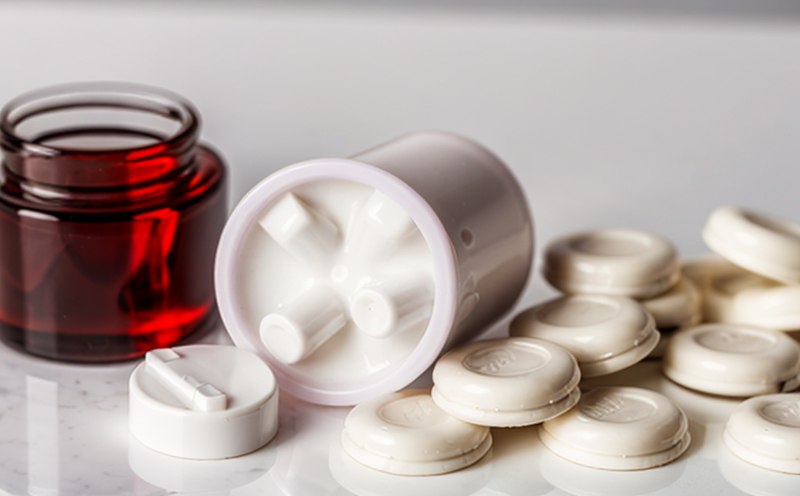USP Identification by Raman Spectroscopy Testing
The United States Pharmacopeia (USP) has established a series of tests to ensure the quality, identity, strength, and purity of pharmaceutical products. Among these tests, USP Identification is crucial for verifying that a given substance corresponds to its intended chemical structure. Raman spectroscopy provides an efficient and non-invasive method for identifying substances based on their unique vibrational modes.
Raman spectroscopy operates by shining laser light onto a sample, causing the molecules within it to vibrate at specific frequencies corresponding to their molecular structure. The scattered light is then collected and analyzed using a spectrometer. Each chemical compound has distinct peaks in its Raman spectrum due to the unique vibrational modes of its molecules. By comparing these spectra against reference standards, Raman spectroscopy can accurately identify unknown compounds.
In pharmaceutical testing, USP Identification by Raman Spectroscopy is particularly valuable for verifying the identity of active pharmaceutical ingredients (APIs) and excipients in oral solid dosage forms such as tablets and capsules. This method ensures that the product meets regulatory requirements without the need for destructive sampling or complex chemical reactions.
The process involves several steps: first, the sample must be prepared according to USP guidelines. For oral solid dosage forms, this typically means grinding the API into a fine powder while ensuring that no excipients are removed. The powdered sample is then placed in a suitable holder for Raman spectroscopy analysis.
The Raman spectrometer records the spectrum of the sample by shining laser light onto it and collecting the scattered light. A high-resolution spectrometer ensures accurate identification, especially when distinguishing between closely related compounds. After acquiring the spectrum, it is compared to reference spectra stored in a database, such as those provided by USP.
One key advantage of using Raman spectroscopy for USP Identification is its non-destructive nature. Unlike other analytical methods like nuclear magnetic resonance (NMR) or mass spectrometry, Raman spectroscopy does not require the sample to be altered in any way. This makes it particularly suitable for testing APIs that are sensitive to changes in their physical form.
Another benefit is its speed and ease of use. A single test can often provide results within minutes, compared to hours or even days required by other methods. This rapid turnaround time is crucial for quality control departments, allowing them to quickly identify any discrepancies between the batch being tested and the approved standard.
The method also offers high sensitivity, making it capable of detecting trace amounts of impurities that could affect the efficacy or safety of the drug product. Furthermore, Raman spectroscopy can be used for in-process monitoring during manufacturing, ensuring consistency throughout production runs.
- Non-Destructive Analysis: No sample preparation is required beyond standard grinding techniques.
- Rapid Results: Typically produces results within minutes.
- High Sensitivity: Detects trace amounts of impurities.
Quality and Reliability Assurance
The reliability and accuracy of USP Identification by Raman Spectroscopy are paramount in maintaining the integrity of pharmaceutical products. To ensure consistent quality, laboratories must adhere to strict protocols and use high-quality equipment calibrated according to international standards.
Quality assurance begins with proper sample preparation as outlined in USP guidelines. This includes ensuring that the API is finely ground without introducing contaminants from excipients. The choice of grinding media can significantly impact the final spectrum, so it must be carefully selected and controlled.
The spectrometer itself requires regular calibration to maintain precision. Calibration should follow standards such as ISO 17025 for proficiency in analytical testing laboratories. Additionally, ongoing training for personnel handling the equipment is essential to ensure they understand best practices for minimizing errors during sample preparation and data interpretation.
Reliability also extends to the software used to analyze the spectra. Advanced algorithms capable of identifying even subtle differences between compounds enhance accuracy. Regular updates to these tools are necessary to keep pace with advancements in spectral analysis and database expansion.
For pharmaceutical companies, implementing robust quality assurance measures not only ensures compliance with regulatory bodies like USP but also builds trust among consumers who rely on consistent product performance. By prioritizing quality at every stage of the testing process, manufacturers can guarantee that their products meet or exceed expectations set forth by regulatory agencies.
International Acceptance and Recognition
The use of Raman spectroscopy for USP Identification has gained widespread acceptance across various international standards bodies. Organizations such as the International Organization for Standardization (ISO), European Pharmacopoeia, British Pharmacopoeia, and others recognize its effectiveness in providing reliable identification of pharmaceutical materials.
One notable example is ISO 17025, which sets criteria for proficiency in analytical testing laboratories. Compliance with this standard ensures that the laboratory conducting Raman spectroscopy tests meets stringent quality assurance requirements. Similarly, adherence to European Pharmacopoeia monographs on specific APIs and excipients requires rigorous validation of identification methods like Raman spectroscopy.
The British Pharmacopoeia also emphasizes the use of spectral analysis techniques in its guidelines for API identification, endorsing Raman spectroscopy as a validated approach. These international standards provide a framework for laboratories worldwide to adopt consistent practices when performing USP Identification tests.
Recognition by these bodies is crucial because it ensures that results obtained through Raman spectroscopy are universally accepted and comparable across different regions. This uniformity supports global trade in pharmaceutical products, reducing barriers to entry for manufacturers operating internationally.





